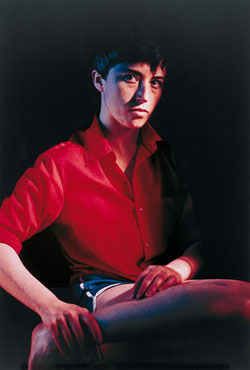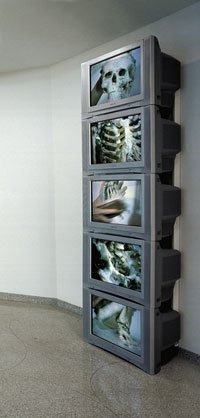Artist
Cindy Sherman Untitled #112 1982

Cindy SHERMAN
American 1954–
Untitled, #112 1982
colour photograph, AP 1/2
117.8 x 81.3 x 6.4 cm
Solomon R. Guggenheim Museum, New York
Purchased with funds contributed by the International Director’s Council and Executive Committee Members: Eli Broad, Elaine Terner Cooper, Ronnie Heyman, J. Tomilson Hill, Dakis Joannou, Barbara Lane, Robert Mnuchin, Peter Norton, Thomas Walther, and Ginny Williams
© Cindy Sherman, courtesy of Metro Pictures, New York
97.4574
"I try to get something going with the characters so that they give more information than what you see in terms of wigs and clothes. I’d like people to fantasise about this person’s life or what they’re thinking or what’s inside their head, so I guess that’s like telling a story."
Cindy Sherman, Serpentine Gallery, London, by Roschelle Steiner Page 12
The act of role-playing is central to the highly successful series Untitled Film Stills made by Cindy Sherman during the late 1970s and very early 1980s. These still images investigate the stereotype of women in film, television and magazines, though they have no basis in any actual film.
Cindy Sherman questions reality in her staged photographs. Her photographs are neither portraits nor self portraits. While the viewer understands that Cindy Sherman acts as both model and photographer in Untitled #112 1982, the character depicted is neither about Sherman or any real character Sherman saw. Rather, she is role-playing. Her figures are fictional, based on B-movie characters; Sherman transforms herself to become these characters.
The images often question the stereotypes of women in the media. The blond bombshell, the reserved tomboy, the femme fatale…The viewer engages with the image asking, who is this person? Why is she depicted in this way? Where have I seen such a figure? Are they real? They reveal more about ourselves; our shortcomings, our inability to look beyond a façade, or our preoccupation with perceptions of beauty and identity. They question society’s overall reliance on the media to define our lives and our place in the world.
"…I don’t want to have to explain myself. The work is what it is and hopefully it’s seen as feminist work, or feminist-advised work."
Cindy Sherman interviewed by Betsy Berne for TATE Modern.
Cindy Sherman purposefully plays with the stereotypes of women and also men to confront her audience with the ways we see and interact with images. The media is an important reference point for Sherman as her characters are often caricatured perceptions that are fed by the media.
The artistic approach of Sherman
Art historian and critic Arthur Danto describes Sherman’s approach:
"She, Cindy Sherman, is…in no sense the subject of these works, even if it is an important fact about them that they are more or less all of her. She is no more their subject that the model for a painting is the subject of the painting, even if it is true that the painting is of that model."
Cindy Sherman, Serpentine Gallery, London, by Roschelle Steiner Page 8
Fredric Jameson is a post modern theorist, who observed:
…the face becoming an impenetrable façade revealing nothing of the self and the skin becomes a plastic wrapping.
Post modernism now, Sherman’s Meditation of Subjectivity by Claire Todd-Miller, 30th October 2006, page 3
